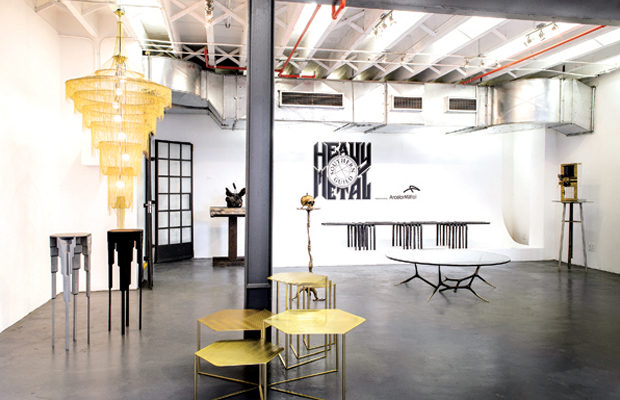 At the Heavy Metal exhibition in Cape Town, one gallery was filled with such designed objects as Tier tables by Pieter Henning (left); Hex tables by Haldane Martin (center); beyond them, a creepy-whimsical Skull Candy by Bronze Age Art Foundry; and Conrad Hicks’s metal Woven bench.
At the Heavy Metal exhibition in Cape Town, one gallery was filled with such designed objects as Tier tables by Pieter Henning (left); Hex tables by Haldane Martin (center); beyond them, a creepy-whimsical Skull Candy by Bronze Age Art Foundry; and Conrad Hicks’s metal Woven bench.
Exhibition
Creative Nation
In South Africa, Design is Fresh, Edgy, and Exciting
On a warm winter’s night in Cape Town, many of South Africa’s design-obsessed (and not a few distinguished tourists) gathered at the former Woodstock Foundry, a rambling complex in an industrial neighborhood rapidly transforming itself into an arts district. The mood was celebratory. Good South African wines (red, white, and sparkling) flowed. A handful of food trucks pulled into the courtyard, and the early-evening DJ was eventually supplanted by live music.
But the night was actually about design: a show called Heavy Metal, mounted by South Africa’s remarkable Southern Guild and featuring ninety-two objects that ranged from tabletop sculpture to a one-ton table (giving even more meaning to the title)—works commissioned from many of the country’s most prominent designers and artists and underwritten by the international metals and mining company ArcelorMittal South Africa. The work itself was pretty astounding—innovative, imaginative, edgy, and energetic. “The work,” says Trevyn Mc-Gowan, who cofounded Southern Guild gallery with her husband Julian in 2008, “has that underlying passion, that beat—a pulse.”
Heavy Metal was keyed to coincide with South Africa’s premiere design event, the international global symposium called Design Indaba. Held annually in late winter, it is a jam-packed, sold-out gathering of any number of the world’s finest design thinkers in mediums that run the gamut from architecture to furniture to graphics to apps to pie-in-the-sky thinking, and it is accompanied by Expo, a show and sale of design ranging from jewelry and fashion (including high-concept tee shirts) to furniture—all of it produced in South Africa.

Southern Guild’s founders, Trevyn and Julian McGowan, sit on Hicks’s Woven bench.
For Americans and even Europeans, this southernmost country on the African continent may seem the end of the world, and in a way it is; the flight from New York City to Johannesburg is the longest nonstop flight departing from JFK airport. And indeed in the past, mostly due to the country’s apartheid policies, its creative product was overlooked, or even embargoed. After apartheid officially ended in 1991, the country was slow to take its place in the international design scene—in part because the local talent that crosses race and class divisions had not been fully cultivated.
Yet now, drawing on a long (and too-long dormant) patrimony of creative work, the country seems on the verge of becoming a bit of a world force in design. “South African design has had a massive surge forward in the last five years especially,” says Bartel van Vuuren, who with his partner Liezle Fourie runs the Sobeit Studio in the small seaside town of Muizenberg. He terms his country a “truly creative nation that acts from impulse and gut feel.”
Next year Cape Town will assume the biennial mantle of World Design Capital, an honor last held in 2012 by Helsinki, Finland. Among those spearheading the year-long celebration of architecture, design, art, and fashion are Trevyn McGowan (and undeniably her Southern Guild has taken the lead in bringing South African design to the rest of the world) and Ravi Nadoo, founder of Design Indaba, which has worked the serious magic of bringing worldclass thinkers and designers (each changing the universe in one way or another) to Cape Town to witness closely the work of a country bursting with talent.
The work being done in South Africa is unique in its perspective, drawing on long traditions that emanate from the diverse cultures and craft traditions of the country, tempered by the influence of Dutch and British (and other) settlers, as South Africa became the melting pot it is today. The work has both a connection to those cultures and a certain strength that draws on sentiment, which in this case makes it even more interesting, to Johannesburg is the longest nonstop flight departing from JFK airport. And indeed in the past, mostly due to the country’s apartheid policies, its creative product was overlooked, or even embargoed. After apartheid officially ended in 1991, the country was slow to take its place in the international design scene—in part because the prodigious talent that crosses race and class divisions had not been fully cultivated.

Conrad Botes’s graphic-inspired hand-knotted rug called Haunted is displayed behind Dylan Lewis’s Gesture 1 table in bronze and glass.
Casting a wide net and a good eye across the country, the McGowans have identified and now showcase some fifty-five South African designers, craftsmen, sculptors, and artists and, and each year it mounts at least one blockbuster show. (Last year’s was at the famed Johannesburg art gallery Everard Read; the Heavy Metal show in Cape Town was just a prelude to another major show in the fall.) But it was at Design Miami in 2011 that the then three-year-old Southern Guild first came to international attention. This was followed almost immediately by its stellar showing at the inaugural Design Days Dubai, repeated in the second year. Collectors were drawn to the freshness of the works on view, which somehow managed to convey a rare combination of innocence and worldliness. “We are quite isolated here,” comments McGowan, noting that the international design shows give her an opportunity “to see who we are within that world forum.”
In May Southern Guild brought work from eighteen designers, including Gregor Jenkin and Dokter and Misses (a polychromed and patterned cabinet called the La La Shwantla cabinet which, says McGowan, “explores a new contemporary African direction for this young design team”); as well as Porky Heffer’s recycled rubber hanging “pod” called Black Hole that is part of his nest series, and a set of small leaf tables called Loves Me, Loves Me Not designed by John Vogel and Justin Plunkett.

The Love Me Love Me Not table designed by John Vogel and Justin Plunkett in wood was shown in New York at the Collective1 Design Fair in May.
This June Southern Guild debuts its roster of South African designers at Design Miami/Basel, in the fall in London; and in December, it comes back to Design Miami in Florida. It is clearly on the rise.
South Africa has long been known for its flourishing art scene, and only in recent years has design begun to follow—with both edgier districts (among them, Woodstock in Cape Town and Braamfontein in Johannesburg) but also more upscale showrooms and galleries in cities throughout the country. Johannesburg’s Parkhurst neighborhood boasts a half dozen shops that showcase the country’s designers and crafts, among them Essential Life (which also has a showroom in Pretoria) and Modernist.
In Cape Town, Adam Court’s luxury lifestyle brand OKHA shares a contemporary five-story building with his oft-time collaborator, the well known South African architectural firm SA OTA . The multifaceted Court, who is among other things an interior designer and a furniture designer, uses his first-floor showroom space not just to showcase his own work— handsome mid-century-inspired furniture— but also other South African design, including ceramics and craft.
Deon Viljoen and his wife Diana Bellew’s gallery (eponymously called Deon Viljoen) is located in the architecturally charming center of South Africa’s wine country, Stellenbosch. Viljoen, an expert on Cape Dutch design, chose the town for what he terms “its exceptional natural beauty” but also because he could find the space to show “unexpected combinations of form, texture, and color by presenting a tightly edited collection of pieces we believe have authenticity, clarity, and simplicity.”
The gallery carries work by notable South Africans (among them, Dokter and Misses) as well as Dutch and English industrial designers, appropriate for a country that emerged from those traditions. Notably, Viljoen and Bellew show engagingly eccentric work by the ceramist Ruan Hoffmann, among others who bridge the gap between design and craft, and they also support fair-trade production that includes contemporary objects made within age-old textile, bead, and other traditions.
That strong connection between craft and design, with the former inspiring the latter, was much in evidence at the Design Indaba Expo, where some of the standouts included the hand-embroidered chair and metal stools and tables from Natalie du Toit’s Indigi Designs, along with evocatively primitive Desert Diaries cushions from Amanda du Plessis’s Evolution Product, and more capricious mirrors and other objects from the irreverent young firm Sobeit. The expo made clear that many of South Africa’s designers are preoccupied with connecting contemporary work with a rich creative culture that has not yet been widely disseminated. A centerpiece of the fair was the curated look at South African design by the former head of the Eindhoven Design Academy, Lidewij Edelkoort, who sought parallels between current work in South Africa and the Memphis movement in Italy. Totemism: Memphis Meets Africa spotlighted works that ran the gamut from clothing to craft to fine art and furniture, including pieces from Ardmore Ceramics (a twenty-eight-year-old studio where some thirty-five potters have found both a calling and employment). Citing the prevalence and freedom of “color, craft, and pattern,” Edelkoort termed it a “great outpour of rustic and organic style including architecture, design, and food, celebrating the well-being of South African life.”
Southern Guild’s Trevyn and Julian McGowan have long been promoters of this outpour, and of the connection of craft to design, primarily through their longer standing endeavor, Source, which for the last decade has linked South African designers and craftsmen with commercial outlets around the world, notably in the United States, where their clients have included Conrans, Restoration Hardware, ABC Carpet and Home, West Elm, and Anthropologie. (Trevyn McGowan was the “costar” in the South Africa episode of the Sundance Channel’s Man Shops Globe, an oddly riveting series in which Anthropologie’s chief buyer Keith Johnson travels in search of unique stock.) The McGowans see Source as both a business and a mission, since orders coming from larger retail operations help employ industrial designers and craftsmen across the country. “We’re helping make a fundamental difference in the way people live,” Trevyn McGowan says.











